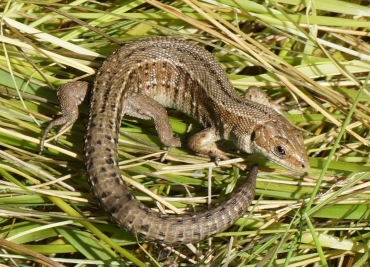Saint Patrick may have gotten rid of Ireland’s snakes but it seems he spared our lizards
 Help put them on the map with the Irish Wildlife Trust.
Help put them on the map with the Irish Wildlife Trust.
Saint Patrick may have gotten rid of Ireland’s snakes but it seems he spared our lizards. Ireland really is home to two fascinating lizard species and this Spring the Irish Wildlife Trust is calling on wildlife enthusiasts to get out lizard spotting to help map Ireland’s wild reptiles.
The IWT National Reptile Survey is asking people to help by sending in any reptile sightings they come across this year or by attending surveyor training days and conducting lizard surveys from April to September. If you would you like to become an IWT citizen scientist, receive surveyor training and carry out reptile surveys in your local area, then register to attend one of the training workshops in counties Tipperary (25 March), Offaly (26 March) or Longford (01 April). To register for a workshop or send in a sighting email
research@iwt.ie or see
www.iwt.ie/reptile.Ireland is home to two species of land dwelling reptile, the viviparous lizard and the slow worm. The viviparous lizard, or common lizard, is a native Irish reptile. This elusive little creature is found throughout Ireland in habitats such as bogland, coastal dunes and the uplands. It is about 13cm long and feeds on small insects, spiders and slugs. This lizard has adapted to the cooler climate by giving birth to live young, a rarity in the reptile world, where most species lay eggs in order to reproduce. Our second wild reptile, the slow worm, is an even more peculiar creature, it look like a small snake but is in fact a legless lizard. Yes, a lizard that adapted to a life without legs, sliding through the undergrowth hunting slugs and slow moving insects. The slow worm is thought to have been introduced to Ireland in the 1970s in the Burren region where it is still found today.
Both species can be seen from March onward basking on sunny rocks, stone walls and earth banks or you may come across them taking refuge under logs or stones. There is usually a peak in lizard sightings in April with a second peak in late August when the young are born and immediately start to fend for themselves hunting and basking just like their parents. If you come across one of these reptiles while out and about the IWT is asking you to get in touch with your reptile record to help them understand the distribution of these two species in Ireland. To report a sighting contact the IWT at
research@iwt.ie with your name, the loc

ation and habitat of the sighting and a photo if possible.
Through this citizen led survey the IWT hopes to determine the current distribution of these two reptile species. This knowledge will allow us to monitor any changes in the population of our native reptile to ensure that any decline does not go unnoticed. Our results should also shed light on any spread of the introduced slow worm and effects this might have on other wildlife. “Citizen science is both extremely engaging and informative. Through projects like this the public can help in the mapping of their own wildlife, thus helping important conservation efforts” says survey coordinator Kieran Flood.
Anyone can volunteer as a surveyor and previous experience is not required. Volunteers on this project are asked to attend training workshops after which they choose an area in their locality to carry out a simple reptile survey, the results of which will be returned to the IWT to compile maps for these species. The workshops will cover Irish terrestrial reptile identification and species recording techniques. To book a place on a workshop or report a lizard sighting, contact us on
research@iwt.ie or see our survey webpage
www.iwt.ie/reptile
We would like to thank Dublin Zoo for supporting this initiative.

 Help put them on the map with the Irish Wildlife Trust.
Help put them on the map with the Irish Wildlife Trust. ation and habitat of the sighting and a photo if possible.
ation and habitat of the sighting and a photo if possible.